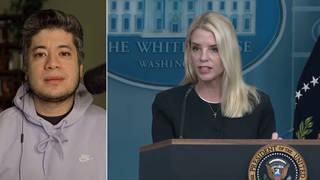
We speak with physicist and professor, Myles Allen who is the principal investigator of a major new study conducted by the ClimatePrediction.net project that warns the effects of global warming may be twice as bad as previously thought. [includes rush transcript]
In Britain, few issues have been covered by the press this past week as much as global warming. On Thursday the Independent ran an article titled “Global Warming is Twice as Bad as Previously Thought.”
That same day the Guardian ran reports of how the US oil industry is funding lobbying groups to fight the British government on global warming. British Prime Minister Tony Blair made headlines when he called on the United States to take a leading role in tackling global warming.
The Independent also reported this week that global warming has caused Mt. Everest to shrink by about four feet. Earlier in the week the Guardian ran an article titled “Global warming near the point of no return.”
Almost every day the British papers ran major new articles on global warming, but these stories have received far less attention here.
Today we go to the University of Oxford to speak with physicist and professor Myles Allen. He is the principal investigator of a major new study conducted by the ClimatePrediction.net project that warns the effects of global warming may be twice as bad as previously thought.
- Myles Allen, physicist at the University of Oxford and principal investigator of the ClimatePrediction.net project.
Transcript
AMY GOODMAN: We’re joined on the telephone by Professor Myles Allen, physicist at University of Oxford. Welcome to Democracy Now!
MYLES ALLEN: Good morning. Yes.
AMY GOODMAN: Good to have you with us. Can you explain the study?
MYLES ALLEN: Thank you very much. Let me begin by thanking more than 25,000 U.S. participants, in case any are listening to your show, who helped us with the study. If it’s one thing they’ve shown— it is amazing actually the amount of computing power these people have contributed— how much we need this in climate research. The point of this study was to look at the uncertainty in climate predictions. One of the gripes of many years on climate prediction from the skeptics’ side has been that these predictions are based on computer models and computer models need you to put things in; and the claim has always been 'garbage in, garbage out'— if you put the wrong numbers in, you might be getting the wrong numbers out. So, what we did to address this head on, was vary all the things we didn’t know about in these models, or many of the things we don’t know about in these models, and ran the simulation many, many times to see what difference it made to the answers. And that’s why we needed to recruit your participants from across the world. As I said, we got more than 95,000 in total—more than 25,000 in the U.S.—building the world’s largest climate modeling facility. And this is how we’ve been able to explore all these different possibilities with these climate models.
JUAN GONZALEZ: When you say that global warming may be twice as bad as previously thought, what does that mean in concrete?
MYLES ALLEN: Right. What we found— here are the two just sort of accepted consensus range of uncertainty in the warming expected if, for example, one were to double pre-industrial carbon dioxide levels—that’s a level of carbon dioxide which is expected within the next few decades— would be between 1.5 and 4.5 degrees Centigrade. Actually I’m not quite sure what that is in Fahrenheit. Anyway, that is the consensus up until now. What we found is these models being fed back to us from our participants show— by just varying the things within the ranges of uncertainty, varying certain aspects of the model within the range of uncertainty— these models are giving us warmings to that same increasing carbon dioxide, ranging to up to over 10 degrees Centigrade. So this is more than double the upper end of the previously accepted range. What this means in concrete terms is that we tend to discuss levels of carbon dioxide that might cause dangerous climate change as if this was something that was likely to happen in the future— maybe twenty, maybe forty, maybe sixty years’ time, and people argue about how soon it will happen. What our results indicate is that there is a chance— it’s not the most likely outcome, but there is a possibility that we may have reached the level of danger— a level of —- carbon dioxides may already be at a level which would ultimately cause a dangerously high level of climate change. So, what this—- to put it into perspective, what these results indicate is that the danger zone is not something we’re likely to reach in fifty years’ time; it could be that we’re in it already.
AMY GOODMAN: Professor Myles Allen, I want to thank you for being with us. Head of the global climate change study that— thanks very much.













Media Options